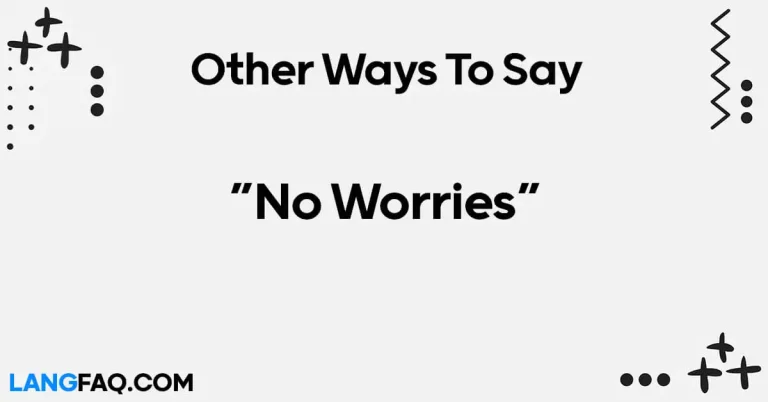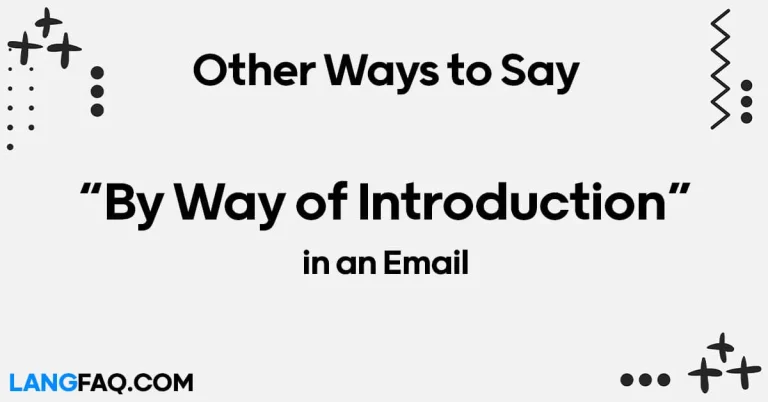Communication is the cornerstone of understanding and connection. In this article, we explore 12 unique ways to express “Let Me Know What You Think.” Mastering diverse communication styles enriches interactions and fosters better relationships. Let’s embark on a journey to refine your expressive abilities.
12 Other Ways to Say “Let Me Know What You Think”
Here are 12 alternative ways to express “Let Me Know What You Think”:
- Share your insights.
- I’m interested in your perspective.
- What’s your take on this?
- How does this resonate with you?
- Feel free to voice your opinion.
- Any thoughts you’d like to contribute?
- Let me in on your thoughts.
- How would you approach this?
- Your feedback is valuable.
- Tell me what’s on your mind.
- I’d love to hear your viewpoint.
- What are your impressions of this?
| Expression | Meaning | Example |
|---|---|---|
| Share your insights | Encourage sharing of unique perspectives or opinions | “Feel free to share your insights on the matter.” |
| I’m interested in your perspective | Express curiosity about someone’s point of view | “I’m genuinely interested in your perspective.” |
| What’s your take on this? | Request an individual’s opinion or stance on a topic | “What’s your take on the new project proposal?” |
| How does this resonate with you? | Inquire about the emotional or personal connection to a subject | “I’m curious how this resonates with you.” |
| Feel free to voice your opinion | Encourage the open expression of thoughts or viewpoints | “Feel free to voice your opinion during the meeting.” |
| Any thoughts you’d like to contribute? | Invite active participation and input | “Any thoughts you’d like to contribute to our discussion?” |
| Let me in on your thoughts | Request inclusion in someone’s reflective or analytical process | “Let me in on your thoughts about the upcoming changes.” |
| How would you approach this? | Seek alternative approaches or solutions to a situation | “Considering your expertise, how would you approach this issue?” |
| Your feedback is valuable | Emphasize the importance of constructive criticism or opinions | “Your feedback is valuable for the improvement of our services.” |
| Tell me what’s on your mind | Encourage open sharing of current thoughts or concerns | “Take a moment and tell me what’s on your mind.” |
| I’d love to hear your viewpoint | Express enthusiasm about hearing someone’s unique perspective | “I’d love to hear your viewpoint on the upcoming changes.” |
| What are your impressions of this? | Request an individual’s overall feelings or impressions | “What are your impressions of the new project proposal?” |
These alternative expressions provide a rich and diverse set of ways to invite others to share their thoughts and opinions. Whether seeking insights, opinions, or emotional responses, using these phrases can enhance communication by fostering openness and collaboration in various contexts.
Is It Correct to Say “Let Me Know What You Think”?
Yes, the phrase “Let Me Know What You Think” is a commonly used and grammatically correct expression. It is an informal and friendly way to invite someone to share their thoughts, opinions, or feedback on a particular subject or matter. This phrase is widely accepted in both written and spoken English, making it suitable for various contexts, including professional, personal, and casual conversations.
In formal writing or professional communication, you might choose to use slightly more formal alternatives, but the original phrase is perfectly acceptable for most everyday situations. It demonstrates openness to receiving input and encourages a collaborative exchange of ideas.
Example Sentence: “I’ve shared the draft proposal with you. Take a look and let me know what you think about the proposed changes.”
Variations for Different Contexts:
- Formal Setting: “I would appreciate it if you could provide your thoughts on the matter.”
- Informal Setting: “Feel free to share your opinions with me.”
- Among Friends: “What’s your take on this? Let me know!”
Professional Mail Example With “Let Me Know What You Think”
Subject: Seeking Your Feedback on Project Proposal
Dear [Recipient’s Name],
I trust this email finds you well. I wanted to bring your attention to the attached project proposal that outlines our strategy for the upcoming quarter. Your insights are highly valued, and I would appreciate it if you could take a moment to review the document.
Let me know what you think about the proposed initiatives, timelines, and any suggestions you may have for improvement. Your expertise plays a crucial role in shaping the success of our projects, and your feedback is instrumental in refining our approach.
Please feel free to share your thoughts by [insert deadline, if applicable]. If you have any questions or require further clarification, do not hesitate to reach out. I am looking forward to hearing your perspective on this matter.
Thank you for your time and contribution.
Best regards,
[Your Full Name] [Your Position] [Your Contact Information]
Share Your Insights
In the realm of effective communication, the phrase “Share Your Insights” serves as an open invitation for individuals to express their unique perspectives. This expression is versatile, suitable for both formal and informal settings, making it a valuable addition to your communicative toolkit.
When to Use:
- Professional Setting: During business meetings or presentations when seeking expert opinions.
- Casual Conversations: Among friends or colleagues when discussing personal or professional matters.
Example Sentence:
“In our upcoming strategy meeting, please feel free to share your insights on the market trends and potential opportunities.”
Dialogue Snippet:
Colleague 1: “I’ve been analyzing the quarterly reports. Any thoughts on the recent market shifts?”
Colleague 2: “Absolutely! Share your insights during the meeting tomorrow.”
Email Sample:
Subject: Your Insights Needed for Tomorrow’s Meeting
Dear [Colleague’s Name],
I hope this email finds you well. As we prepare for tomorrow’s strategy meeting, I would greatly appreciate it if you could share your insights on the market trends and potential opportunities. Your expertise is invaluable to the team, and your input will contribute significantly to our discussions.
Looking forward to hearing from you soon.
Best regards,
[Your Name]
Variations:
- Formal: “Could you kindly provide your insights on…”
- Informal: “Mind sharing your thoughts on…”
Dictionary Insight:
Cambridge Dictionary defines ‘insight’ as the ability to have a clear, deep, and sometimes sudden understanding of a complicated problem or situation.
Tips:
- Encourage Specificity: Ask for insights on particular aspects to guide responses effectively.
- Express Gratitude: Acknowledge the value of shared insights to foster a positive environment.
I’m Interested in Your Perspective
The phrase “I’m Interested in Your Perspective” conveys a genuine curiosity about someone’s point of view, fostering a sense of collaboration and inclusivity in both professional and personal conversations.
When to Use:
- Workplace Discussions: When seeking diverse opinions on a project or decision.
- Friendship Conversations: In casual settings when exploring each other’s thoughts on various topics.
Example Sentence:
“As we strategize for the upcoming project, I’m genuinely interested in your perspective on the proposed timeline.”
Dialogue Snippet:
Friend 1: “What do you think about the new movie?”
Friend 2: “I’m interested in your perspective. How did you find it?”
Email Sample:
Subject: Seeking Your Perspective on Project Timeline
Dear [Colleague’s Name],
I trust this email finds you well. As we delve into the details of the upcoming project, I’m genuinely interested in your perspective on the proposed timeline. Your insights will play a crucial role in shaping our approach.
Looking forward to hearing from you soon.
Best regards,
[Your Name]
Variations:
- Formal: “Your professional perspective on…”
- Informal: “I’d love to know what you think about…”
Dictionary Insight:
Perspective is defined by Cambridge Dictionary as a particular way of considering something, often influenced by your beliefs and experiences.
Tips:
- Create a Safe Space: Ensure individuals feel comfortable sharing diverse perspectives.
- Avoid Judgment: Emphasize curiosity over evaluation to encourage openness.
What’s Your Take on This?
In the art of communication, the phrase “What’s Your Take on This?” acts as an inclusive inquiry, inviting individuals to share their opinions on a given topic. This expression seamlessly integrates into both formal and informal conversations, adding a touch of friendliness to discussions.
When to Use:
- Team Meetings: Initiating discussions to gather opinions on project-related matters.
- Social Gatherings: Encouraging friends to contribute their thoughts on various subjects.
Example Sentence:
“Before we finalize the agenda, what’s your take on including a brief Q&A session at the end of the presentation?”
Dialogue Snippet:
Colleague 1: “We need to decide on the venue for the conference. Any suggestions?”
Colleague 2: “Absolutely. What’s your take on hosting it at the convention center?”
Email Sample:
Subject: Seeking Your Input on Tomorrow’s Agenda
Dear [Colleague’s Name],
I hope this message finds you well. As we prepare for tomorrow’s meeting, I’d like to hear your take on the agenda. Your input is highly valued, and I believe it will enhance our discussion.
Looking forward to your insights.
Best regards,
[Your Name]
Variations:
- Formal: “Could you kindly share your take on…”
- Informal: “What do you reckon about…”
Dictionary Insight:
Take, in this context, refers to Cambridge Dictionary’s definition as a particular way of understanding or thinking about something.
Tips:
- Encourage Conciseness: Prompt individuals to express their opinions succinctly.
- Express Openness: Demonstrate a willingness to consider various viewpoints.
How Does This Resonate With You?
Inviting an emotional or personal connection to a subject, the phrase “How Does This Resonate With You?” adds a layer of depth to communication. It’s particularly effective in situations where understanding personal reactions is crucial.
When to Use:
- Creative Collaborations: Seeking emotional responses to artistic or innovative ideas.
- Team Building: Encouraging individuals to connect on a personal level with a proposed change.
Example Sentence:
“As we explore potential rebranding strategies, how does this resonate with you on a personal level?”
Dialogue Snippet:
Team Leader: “We’re considering a shift in our project approach. Thoughts?”
Team Member: “Sure. How does this resonate with you, considering our team dynamics?”
Email Sample:
Subject: Seeking Your Emotional Response to Proposed Changes
Dear [Colleague’s Name],
I hope this message finds you in good spirits. As we delve into potential changes, I’m interested in how these resonate with you on a personal level. Your emotional insights are valuable to the team.
Looking forward to your thoughts.
Best regards,
[Your Name]
Variations:
- Formal: “Could you provide your emotional response to…”
- Informal: “How do you feel about…”
Dictionary Insight:
Resonate is defined as producing a positive feeling, emotional response, or opinion.
Tips:
- Encourage Self-Reflection: Prompt individuals to connect with their emotions regarding the subject.
- Acknowledge Emotions: Express gratitude for sharing personal sentiments.
Feel Free to Voice Your Opinion
Encouraging open expression, the phrase “Feel Free to Voice Your Opinion” creates an environment where individuals feel comfortable sharing their thoughts. This expression is particularly useful in fostering a culture of collaboration and inclusivity.
When to Use:
- Team Brainstorming Sessions: Welcoming diverse opinions to solve complex problems.
- Group Decision-Making: Encouraging open discussions before reaching a consensus.
Example Sentence:
“As we explore potential changes in our workflow, feel free to voice your opinion on how it may impact your team.”
Dialogue Snippet:
Meeting Facilitator: “We’re deciding on the new project timeline. Any thoughts?”
Team Member: “Feel free to voice your opinion, everyone. It’s crucial for our success.”
Email Sample:
Subject: Seeking Your Opinions on Proposed Workflow Changes
Dear [Colleague’s Name],
I trust this email finds you well. As we consider changes in our workflow, I encourage you to feel free to voice your opinion. Your insights are integral to this decision-making process.
Looking forward to hearing from you soon.
Best regards,
[Your Name]
Variations:
- Formal: “Kindly share your opinions on…”
- Informal: “Don’t hesitate to speak up about…”
Dictionary Insight:
The term ‘voice’ in this context refers to expressing opinions or feelings, as defined by Cambridge Dictionary.
Tips:
- Create a Supportive Environment: Emphasize that all opinions are valued.
- Acknowledge Contributions: Thank individuals for sharing their thoughts to reinforce a positive culture.
Any Thoughts You’d Like to Contribute?
The phrase “Any Thoughts You’d Like to Contribute?” is an open invitation for active participation, emphasizing the value placed on each individual’s input. It can be seamlessly integrated into both professional and casual conversations.
When to Use:
- Team Collaborations: Encouraging brainstorming sessions for new ideas.
- Social Gatherings: Inviting friends to share their perspectives on various topics.
Example Sentence:
“Before we finalize the project proposal, any thoughts you’d like to contribute to enhance our approach?”
Dialogue Snippet:
Project Manager: “We’re finalizing the marketing strategy. Ideas, anyone?”
Team Member: “Any thoughts you’d like to contribute? Let’s make this campaign outstanding.”
Email Sample:
Subject: Seeking Your Contributions to Project Proposal
Dear [Colleague’s Name],
I hope this message finds you in good spirits. As we near the finalization of our project proposal, I’m reaching out to ask if there are any thoughts you’d like to contribute. Your input is invaluable to our success.
Looking forward to your insights.
Best regards,
[Your Name]
Variations:
- Formal: “Your valuable contributions to…”
- Informal: “Feel free to throw in any ideas about…”
Dictionary Insight:
Contribute is defined as giving or adding something valuable to a particular thing or activity.
Tips:
- Encourage Diverse Ideas: Stress the importance of varied perspectives.
- Acknowledge Contributions: Express gratitude for the thoughts shared during discussions.
Let Me in on Your Thoughts
Inviting others to share their thoughts, the phrase “Let Me in on Your Thoughts” creates a sense of inclusion and collaboration. This expression is powerful in both professional and personal settings, fostering an environment where individuals feel valued for their input.
When to Use:
- Decision-Making Processes: Seeking insights before finalizing crucial decisions.
- Group Discussions: Encouraging open sharing in collaborative settings.
Example Sentence:
“Before we conclude the team meeting, let me in on your thoughts about the proposed changes in our project timeline.”
Dialogue Snippet:
Team Leader: “We’re considering a new approach. Opinions?”
Team Member: “Sure, let me in on your thoughts. How do you feel about the proposed changes?”
Email Sample:
Subject: Your Thoughts Needed on Project Timeline Adjustments
Dear [Colleague’s Name],
I trust this email finds you well. As we navigate potential adjustments to our project timeline, I would appreciate it if you could let me in on your thoughts. Your insights are crucial to our decision-making process.
Looking forward to hearing from you soon.
Best regards,
[Your Name]
Variations:
- Formal: “Could you please share your thoughts on…”
- Informal: “Mind letting me know what you think about…”
Dictionary Insight:
The phrase “let in on” is an idiomatic expression that means allowing someone to be part of or have information about something.
Tips:
- Express Appreciation: Let individuals know their thoughts are valued.
- Encourage Openness: Emphasize that all perspectives are welcome.
How Would You Approach This?
In situations requiring creative problem-solving, the phrase “How Would You Approach This?” encourages individuals to share alternative perspectives and solutions. This expression is particularly effective when brainstorming ideas or addressing challenges.
When to Use:
- Project Planning: Seeking innovative approaches to overcome obstacles.
- Mentorship Context: Encouraging mentees to develop problem-solving skills.
Example Sentence:
“Considering your expertise in marketing, how would you approach increasing engagement for our upcoming campaign?”
Dialogue Snippet:
Team Lead: “We need fresh ideas for our client pitch. Suggestions?”
Team Member: “How would you approach this, given your experience in client engagement?”
Email Sample:
Subject: Seeking Your Approach to Client Engagement
Dear [Colleague’s Name],
I hope this email finds you well. Given your extensive experience in client engagement, I’m interested in how you would approach enhancing our strategy for the upcoming pitch. Your insights are highly valued.
Looking forward to hearing from you soon.
Best regards,
[Your Name]
Variations:
- Formal: “Could you provide your approach to…”
- Informal: “What’s your take on how to handle…”
Dictionary Insight:
Approach, in this context, refers to a way of dealing with a situation or problem.
Tips:
- Acknowledge Expertise: Highlight the individual’s skills before posing the question.
- Encourage Creativity: Emphasize the freedom to explore innovative approaches.
Your Feedback is Valuable
Expressing the significance of constructive criticism or opinions, the phrase “Your Feedback is Valuable” emphasizes the importance of individual contributions. This expression is crucial in both professional and personal scenarios, fostering a culture of continuous improvement.
When to Use:
- Project Reviews: Gathering insights for project refinement.
- Collaborative Environments: Encouraging open feedback to enhance teamwork.
Example Sentence:
“As we review the latest project outcomes, your feedback is valuable in shaping our future strategies and refining our approach.”
Dialogue Snippet:
Team Lead: “We’ve completed the first phase. Thoughts?”
Team Member: “Your feedback is valuable in ensuring we fine-tune our strategy for the next phase.”
Email Sample:
Subject: Seeking Your Feedback on Project Outcomes
Dear [Colleague’s Name],
I trust this email finds you in good spirits. As we reflect on the outcomes of our latest project phase, I’d like to emphasize that your feedback is valuable. Your insights will contribute significantly to our ongoing success.
Looking forward to hearing from you soon.
Best regards,
[Your Name]
Variations:
- Formal: “Could you kindly provide your feedback on…”
- Informal: “We’d love to hear your thoughts on…”
Dictionary Insight:
Feedback, defined by Cambridge Dictionary, is information or statements of opinion about something, such as a new product, that can tell you if it is successful or liked.
Tips:
- Highlight Impact: Show how individual feedback contributes to overall success.
- Encourage Specifics: Prompt detailed insights rather than generic comments.
Tell Me What’s on Your Mind
Encouraging open sharing of current thoughts or concerns, the phrase “Tell Me What’s on Your Mind” is a straightforward invitation for individuals to express themselves. This expression is versatile, suitable for both professional and personal conversations.
When to Use:
- One-on-One Discussions: Establishing open communication channels.
- Team Check-Ins: Inviting team members to share any concerns or ideas.
Example Sentence:
“Before we conclude the meeting, take a moment and tell me what’s on your mind. Your thoughts matter to the team.”
Dialogue Snippet:
Supervisor: “Any concerns or ideas you’d like to share before we wrap up?”
Team Member: “Sure, tell me what’s on your mind. I appreciate the opportunity to discuss a few ideas.”
Email Sample:
Subject: Seeking Your Thoughts Before Our Meeting Ends
Dear [Colleague’s Name],
I hope this message finds you well. Before we conclude our meeting, I want to give you the opportunity to tell me what’s on your mind. Your thoughts and concerns are valuable, and I’m here to listen.
Looking forward to hearing from you soon.
Best regards,
[Your Name]
Variations:
- Formal: “Could you please share what’s on your mind regarding…”
- Informal: “Feel free to let me know what you’re thinking about…”
Dictionary Insight:
The phrase “on your mind” refers to thoughts or feelings that someone is thinking about.
Tips:
- Express Availability: Assure individuals that you are open and ready to listen.
- Encourage Honesty: Emphasize the value of transparent communication.
I’d Love to Hear Your Viewpoint
Expressing enthusiasm about hearing someone’s unique perspective, the phrase “I’d Love to Hear Your Viewpoint” adds a personal touch to communication. This expression is effective in various settings, creating a positive atmosphere for exchanging ideas.
When to Use:
- Team Discussions: Encouraging team members to share their insights.
- Collaborative Projects: Fostering a culture of appreciation for diverse viewpoints.
Example Sentence:
“As we delve into the new project, I’d love to hear your viewpoint. Your unique perspective is invaluable to our success.”
Dialogue Snippet:
Project Manager: “We’re approaching the project differently. Thoughts?”
Team Member: “Absolutely, I’d love to hear your viewpoint on the proposed changes.”
Email Sample:
Subject: Seeking Your Viewpoint on Project Approach
Dear [Colleague’s Name],
I trust this message finds you well. As we embark on the new project, I’d love to hear your viewpoint. Your unique perspective contributes significantly to our collaborative efforts.
Looking forward to your insights.
Best regards,
[Your Name]
Variations:
- Formal: “Could you kindly share your viewpoint regarding…”
- Informal: “I’d be thrilled to know what you think about…”
Dictionary Insight:
Viewpoint is defined as a particular way of considering or seeing something.
Tips:
- Express Enthusiasm: Show genuine excitement about hearing the individual’s perspective.
- Acknowledge Uniqueness: Emphasize the value of their unique viewpoint.
What Are Your Impressions?
Inviting individuals to share their overall feelings or impressions, the phrase “What Are Your Impressions?” encourages a more subjective and personal response. This expression is particularly useful when seeking feedback that goes beyond facts and figures.
When to Use:
- Project Evaluations: Gathering subjective feedback on project outcomes.
- Product Reviews: Inviting users to share their emotional responses.
Example Sentence:
“As we wrap up the presentation, what are your impressions? I’m interested in understanding the emotional impact of our work.”
Dialogue Snippet:
Team Lead: “We’ve reached the final phase. How does it look to you?”
Team Member: “What are your impressions? I’d like to hear your thoughts on the overall presentation.”
Email Sample:
Subject: Seeking Your Impressions on Project Completion
Dear [Colleague’s Name],
I hope this email finds you in good spirits. As we conclude the project, I’m reaching out to ask for your impressions. I’m particularly interested in understanding the emotional impact of our work.
Looking forward to your insights.
Best regards,
[Your Name]
Variations:
- Formal: “Could you please provide your impressions regarding…”
- Informal: “I’m curious to know what your gut feeling is about…”
Dictionary Insight:
Impressions, in this context, refer to the overall feelings or opinions someone has about something.
Tips:
- Encourage Emotional Expression: Prompt individuals to share their emotional responses.
- Acknowledge Subjectivity: Emphasize the value of personal impressions in shaping decisions.
FAQs
Q: Can I use these phrases in professional settings? Absolutely! These expressions are versatile and can be adapted to various contexts, including professional communication. They add a touch of professionalism while maintaining a friendly tone.
Q: How do these phrases contribute to effective communication? Using diverse expressions encourages open dialogue, promotes inclusivity, and fosters a culture of respect. It enhances communication by inviting varied perspectives.
Q: Can I mix and match these phrases in a conversation? Certainly! Feel free to experiment and use a combination of these phrases to tailor your communication style based on the context and individuals involved.
Q: Are these alternatives suitable for written communication? Yes, these expressions can be seamlessly integrated into written communication, such as emails, reports, or any form of written correspondence.
Q: Will using these phrases make me a better communicator? Absolutely! Embracing diverse expressions enriches your communication skills, making you a more effective and engaging communicator.
Q: How can I remember to use these alternatives in daily conversations? Practice incorporating these phrases into your everyday communication. Over time, they will become a natural part of your expressive repertoire.
Conclusion:
Mastering the art of expressing “Let Me Know What You Think” is a journey towards becoming a more effective and empathetic communicator. Embrace these alternatives, experiment with your communication style, and witness the transformative impact on your relationships and interactions.







